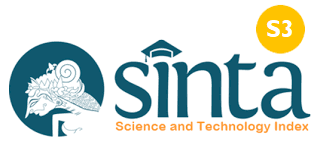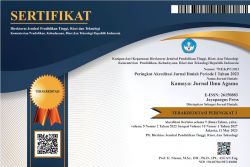Sistem Informasi Pengembangan Website Digitalisasi Katalog Lontar Di Kabupaten Tabanan Kecamatan Selemadeg
DOI:
https://doi.org/10.37329/kamaya.v8i2.4038Keywords:
Lontar Preservation, Information System, Digitization, Lontar Catalog, Local CultureAbstract
Strengthening the preservation of lontar in the form of digitisation needs to continue to be developed as an effort to maintain and develop the knowledge stored in lontar so that it is suitable for reading and use in everyday life. The purpose of this study is as a form of preservation, to create a catalog of lontar in tabanan regency, selemadeg district through the process of developing a digitalization website for the lontar catalog in tabanan regency. The method used in this research on the digitisation of lontar catalogues with web-based information systems uses a waterfall approach, which consists of concept planning, modelling (design), implementation, testing and maintenance stages. The results of this study found that lontars that were 30 years old, there were lontars that had not been properly stored and were left alone by their owners, so that the lontars were damaged by termites and rodents, therefore there must be an effort to save the storage of lontar owners so that lontars do not become extinct. Where researchers have carried out the process of digitizing lontar manuscripts in tabanan regency, selemadeg district so that the original physical form of the lontar manuscript as an ancestral heritage can be preserved and the information contained therein can be saved. All lontar manuscripts in tabanan regency, selemadeg district are cataloged so that they are easy to store and access. Lontar that has been made into digital form currently contains 31 digital lontar manuscripts that will be cataloged to facilitate providing information online, in the form of digital storage which makes it easier to identify the owner of the original lontar containing the status and origin of the lontar. This research aims to save lontar by creating a catalog of lontar in tabanan regency as a form of preserving local culture for lontar owners and future generations.
References
Arthur, R., Sulaiman, N., & Nurviana, N. (2010). Naskah Lontar Bali Sebagai Sumber Gagasan Desain Buku dalam Desain Komunikasi Visual. Bandung: Universitas Kristen Maranatha.
Ardiyasa, I. N. S. (2021). Eksistensi Naskah Lontar Masyarakat Bali (Studi Kasus Hasil Pemetaan Penuyuluh Bahasa Bali Tahun 2016-2018). Kalangwan Jurnal Pendidikan Agama, Bahasa dan Sastra, 11(1), 74-82.
Bhandesa, A. M., Wulansari, N. T., & Susanta, I. P. A. E. (2022). Kajian Nilai dan Konsep Pengobatan Tradisional Pada Lontar Usada Yeh. Jurnal Penelitian Agama Hindu, 6(1), 13-23.
Deegan, M., & Tenner, S. (2002). Digital Futures Strategies For The Information Age. New York: Neal-Schuman.
Didik, S. (2017). Buku Sakti Pemrograman Web: HTML, CSS, PHP, MySQL & Javascript. START UP: Yogyakarta.
Dinas Kebudayaan Kabupaten Badung. (2015). Digitalisasi Lontar Kalpa Sastra. Denpasar: Dinas Kebudayaan Kabupaten Badung.
Fitri, R. (2020). Pemrograman Basis Data Menggunakan MySQL. Banjarmasin: Poliban Press
Hidayat, A. N. (2015). Belajar HTML Kelas Ringkas. Bogor: Bisakimia.
Husna, A. (2013). Pelestarian Kandungan Informasi dengan Alih Media Digital. Pemerintah Provinsi Jawa Barat.
Jelantik, I. B. (2002). Problematika Upaya Pelestarian Naskah Lontar di Bali. Majalah Dokumentasi Budaya Bali.
Kaban, R., & Sembiring, D. J. (2021). HTML (Hypertext Markup Language) Pengantar Pemrograman Berbasis Web. Solok: CV. Mitra Cendekia Media.
Mulyana, N. M. N., & Aminah, S. (2023). Web-Based Inventory Information System At SMA Negeri 1 Babakancikao Purwakarta: Web-Based Inventory Information System At SMA Negeri 1 Babakancikao Purwakarta. Barometer, 8(2), 111-118.
Putra, I. B. R. (2015). Lontar Bali; Manuskrip Penampang Peradaban Berkarakter. Naskah Seminar Nasional Potensi Naskah Lontar Bali yang Bernilai Luhur dalam Penguatan Jati Diri Bangsa, UPT Perpustakaan Lontar Udayana.
Raharjo, S. H., Budiastra, K., & Suhardi, U. (2023). Fenomena Generasi Muda Dalam Aktivitas Ritual Keagamaan Hindu di Pura Parahyangan Jagat Guru Tangerang Selatan: (Studi Hiperealitas Jean Boudrilard). Jurnal Penelitian Agama Hindu, 7(4), 478-493.
Rangkuti, L. A. (2012). Penerapan Digitalisasi Untuk Perpustakaan. Iqra': Jurnal Perpustakaan dan Informasi, 6(2), 59-64.
Sudarsana, I. M. (2024). Conservation of Hindu Religious Lontar Manuscripts Through Lontar Digitization Website Information System in Tabanan Regency. Jurnal Penelitian Agama Hindu, 8(4), 535-547.
Suartha, N., Suastika, I. M., Jirnaya, I. K., Puspawati, L. P., Sulibra, I. K. N., Wijana, I. M., Suardiana, I. W., Putra, I. B. R., Antara, I. G. N., Sancaya, I. D. G. W., Suteja, I. W., Yasa, P. E. G., & Sukersa, I. W. (2016). Prabhanjnana Kajian Pustaka Lontar Universitas Udayana. Denpasar: Pustaka Larasan.
Sukmana, E. (2015). Peran Pustaka pada Era Digital. UPT Perpustakaan Institut Teknologi Bandung.
Simangunsong, A. (2018). Sistem Informasi Pengarsipan Dokumen Berbasis Web. Jurnal Mantik Penusa, 2(1).
Sutriyanti, N. K., Luwih, I. M., & Suandewa, I. G. L. A. (2024). Implementasi Kurikulum Merdeka dalam Pembelajaran Pendidikan Agama Hindu dan Budi Pekerti Pada Jenjang SMP di Kabupaten Bangli. Jurnal Penelitian Agama Hindu, 8(2), 193-211.
Salamah, U. G. (2021). Tutorial Visual Studio Code. Bandung: CV. Media Sains Indonesia.
Tajuddin, M., Adil, A., Hidayat, S., Abidin, Z., & Priniti, R. F. (2019). Naskah Lontar Sasak di Era Industri 4.0 Berbasis Cots Method. Prosiding Sains Nasional dan Teknologi, 1(1).
Trinawindu, I. B. K., Artawan, C. A., & Cahyadi, I. W. A. E. (2015). Pelestarian Prasi Dengan Teknologi Digital. Segara Widya: Jurnal Penelitian Seni, 3(1), 368-374.
Wirayati, M. A. (2013). Konservasi Manuskrip Lontar. Jakarta: Perpustakaan Nasional RI.
Wartayasa, I. K. (2018). Pelaksanaan Upacara Yadnya Sebagai Implementasi Peningkatan dan Pengamalan Nilai Ajaran Agama Hindu. Kamaya: Jurnal Ilmu Agama, 1(3), 186-199.
Zakiyyah, F. N., Damayanti, N. A., Khadijah, U. L., & Khoerunnisa, L. (2022). Preservasi Naskah Kuno Pada Yayasan Sastra Lestari Berbasis Digital. Al-Kuttab: Jurnal Kajian Perpustakaan, Informasi dan Kearsipan, 4(2), 1-12.
Downloads
Published
How to Cite
Issue
Section
License
Copyright (c) 2025 Kamaya: Jurnal Ilmu Agama

This work is licensed under a Creative Commons Attribution-ShareAlike 4.0 International License.
An author who publishes in the Kamaya : Jurnal Ilmu Agama agrees to the following terms:
- Author retains the copyright and grants the journal the right of first publication of the work simultaneously licensed under the Creative Commons Attribution-ShareAlike 4.0 License that allows others to share the work with an acknowledgement of the work's authorship and initial publication in this journal
- Author is able to enter into separate, additional contractual arrangements for the non-exclusive distribution of the journal's published version of the work (e.g., post it to an institutional repository or publish it in a book) with the acknowledgement of its initial publication in this journal.
- Author is permitted and encouraged to post his/her work online (e.g., in institutional repositories or on their website) prior to and during the submission process, as it can lead to productive exchanges, as well as earlier and greater citation of the published work (See The Effect of Open Access).
Read more about the Creative Commons Attribution-ShareAlike 4.0 Licence here: https://creativecommons.org/licenses/by-sa/4.0/.





